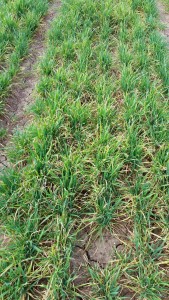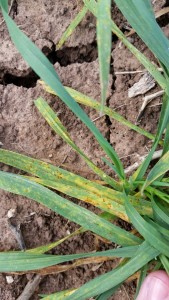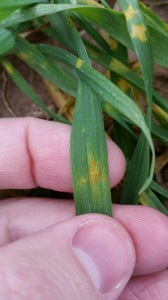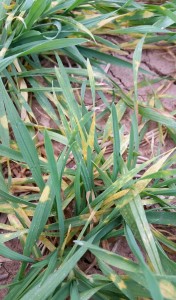by Dr. Clark Neely, Small Grains/Oilseeds Extension Specialist – College Station, TX; Dr. Ron French, Grain and Vegetable Extension Plant pathologist – Amarillo, TX
It is now February and we are once again seeing significant rust levels in wheat in areas of Southern and Southeast Texas. The elevated levels of rust this early in the season is eerily similar to 2015; however, leaf rust appears to be more prevalent at this time than stripe rust, unlike 2015. Currently, wheat planted prior to December 1 seems to be most affected with more foliage available for infection. Wheat observed in Hill and Williamson Counties was planted late (mid-December) and seed was slow to germinate and therefore little or no rust was present. Leaf rust appears to be heaviest in the College Station area and south. Though stripe rust is not widespread, one “hot spot” was identified in plots near College Station (Figures 3 and 4) on susceptible wheat. Other reports indicate active stripe rust on the Gulf Coast, Uvalde, and Northeast Texas on susceptible varieties.
Mild temperatures and wet conditions have led to the build-up of this disease and levels are high enough that wheat leaves are yellowing and plants are stressed (Figures 1 and 2). Without a significant cold snap to knock the disease back, inoculum levels are primed to spread to other regions of the state once temperatures begin to warm up and the crop advances further north. Another key factor that will influence the development and spread of rust this spring will be moisture conditions across the state. The most recent long term forecast from the National Weather Service indicates a continuing El Niño through the spring, which brings with it an elevated chance of above normal rainfall for the state of Texas and conducive conditions for rust development.
Although fungicide applications are generally not warranted this time of year, producers in Central Texas and south should be scouting fields regularly now for disease. If rust is detected and mild, wet conditions are expected in the near future for your area, a fungicide application may be warranted. Even if weather conditions do favor disease development, other northern regions of the state should not expect to see any rust for another one to two months. Keep in mind that hot temperatures and dry conditions can halt disease progression quickly, although leaf rust will tolerate warmer temperatures (85 degree F and slightly higher) compared to stripe rust which may lose viability. Freezing temperatures may render leaf rust spores unviable but that is not the case with stripe rust spores.
When considering an early season fungicide application, producers should consider whether they have planted a leaf or stripe rust susceptible variety. If rust is detected on a resistant variety, the progression of the disease may be slow and reduce the need for a fungicide application. The most current resistance ratings for wheat varieties can be found in the 2015 Texas Wheat Variety Trial Results publication (http://varietytesting.tamu.edu/wheat/index.htm). Other factors to take into account are yield potential, type of irrigation (which can increase moisture levels), other fungal diseases present, age of the plant, and where pustules can be found in the canopy in relationship to the flag. Regardless of the fungicide used, producers should not expect an early season application to last the rest of the season. Under the right conditions, a subsequent fungicide application may be needed around flag leaf emergence to protect the plant through grain fill. It is important to scout a field and observe rust infection in both the lower and upper canopy, as humidity may favor rust increase in lower leaves which can later move up into the canopy once humidity levels increase due to higher moisture levels in the upper leaves. For proper disease identification refer to Texas A&M AgriLife Extension publication titled “Identifying Rust Diseases of Wheat and Barley” (http://amarillo.tamu.edu/files/2010/11/RustDiseasesTexas.pdf). Additional information on diseases in wheat and a list of available fungicides can be found at http://amarillo.tamu.edu/amarillo-center-programs/extension-plant-pathology/wheat-publications/. Fungicides efficacy trial results can be found at http://varietytesting.tamu.edu/wheat.
In summary, further development and spread of rust in wheat on a statewide or regional scale depends heavily on weather conditions. If dry conditions prevail, statewide impact will be substantially lower, but the prospect of a continuing El Niño means rust could be a real concern once again this spring and producers need to be attentive to their wheat fields as the season progresses.

Figure 1. Leaf rust causing obvious yellowing and leaf desiccation in susceptible winter wheat in College Station, TX on February 2, 2016

Figure 2. Leaf rust pustules on winter wheat leaves in College Station, TX on February 2, 2016.

Figure 3. Strip rust pustules on winter wheat leaf in College Station, TX on February 2, 2016

Figure 4. Strip rust causing lesions and yellowing of leaves in susceptible winter wheat in College Station, TX on February 2, 2016

Clark Neely
State Small Grains Agronomist
College Station, TX
cbneely@tamu.edu